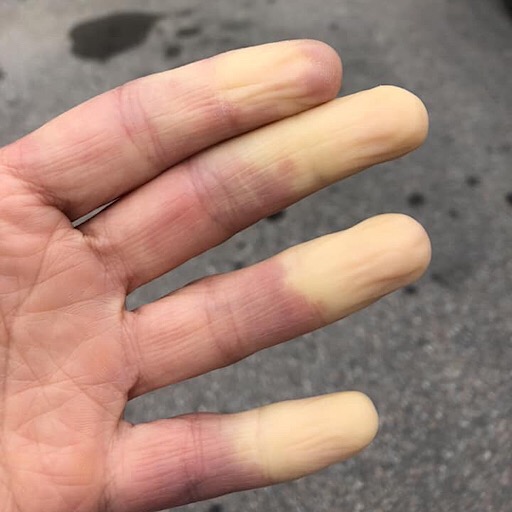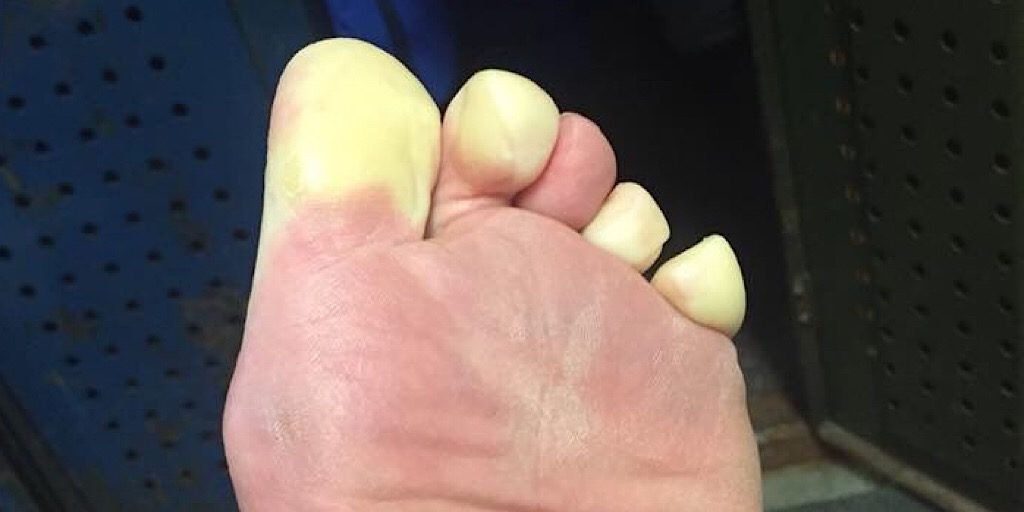
Raynauld signs/symptoms. Photo by Rose Marie Owens.

From a trip to the grocery store. Photo by Shelley Rand.
A reversal treatment for Raynaud syndrome would be a welcome relief for many…
My hands feel really numb, lifeless, and they look cold — freezing cold. My fingers are a waxy white. The temperature is only 40°F and the wind is hardly blowing. I’m hiking and should feel great, warm from exercise. And I am, except for my numb, dead-looking hands.
If the photos on this page or this quote (see right) describes you and any of your extremities, you may have Raynaud Syndrome (a.k.a. Raynaud Phenomenon or Raynaud Disease). This, of course, is something you’ll want to discuss with your doctor. We won’t go into too much detail about the syndrome itself instead focusing here mostly on a method of reversing it so you can feel “normal” again, but in essence the circulatory loops in our extremities vasoconstrict in response to even moderate upper body chilling. This can result in visibly bloodless digits or worse, plus possible tingling or numbness. Of great concern to cold weather hikers, skiers, and others, the condition also increases the risk for frostbite.
The process of treating this condition with the intention of reversing it was described by Dr. Frank Hubbell, founder of Stonehearth Open Learning Opportunities (SOLO) — Dr. Hubbell, however, credits his close, personal friend Dr. Murray Hamlet for devising this imaginative yet simple and logical technique.
To be successful this process requires only a modicum of effort, but a it does take fair amount of time and one must be committed to the process. Since this must be done when it’s below freezing outside you must wait for winter to begin, though a walk-in freezer could be used if you have access to one. To try it, please follow these steps:
Preparatory Steps
- Wear a t-shirt or something similar, something lightweight for this procedure.
- Fill two coolers with warm water ~103-105°F and be prepared to measure and maintain this temperature.
- Put one cooler outdoors (or in freezing conditions) and one cooler indoors.
The Actual Process
- Starting indoors soak your hands in that cooler for 5 minutes.
- Move outdoors, still wearing the t-shirt, and soak your hands in that cooler for 5 minutes.
- Then repeat step 1 indoors and that will complete one “cycle.”
- Repeat this “cycle” 3 times per day (9 soakings, 6 inside, 3 outside), keeping track of total cycles.
- Continue this procedure for at least 50 cycles over time (roughly 16 days).
That’s it, as was explained by Dr. Hubbell. Outdoors (or in a freezer) your body will be cold and the loops will simply shut down — as a safety mechanism — but your hands will be fine and this is going to cause some conflict within your body (think mixed messages). According to the good doctor, after the fifty cycles or more, completed over time, your loops will stop responding to your upper body temperatures and no longer close. Your hands will start feeling much warmer in the winter. Untreated, he said sufferers would become more and more susceptible to cold injuries, and more so each time they occur.

Other extremities may be affected, such as the toes. Photo by Sasha Holmes.
Hopefully this procedure is effective for the majority of people who try it out. Dr. Hubbell sounded very confident. If you try it and find it works for you, please feel free to share this piece with others.
In The Meantime
Protect yourself from cold injury if you suffer from this malady as allowing it worsens the condition making you more prone to injury. A good way to do this is through preparation, just like the other things we do before we go hiking. A few key preparations can save us some pain.
- Employ Layering
- Just as we do with our core body parts, protecting ourselves by way of layering is smart and effective. For our hands we find using a system of liner glove, insulating mitt, with a wind/rain shell on the outside, quite effective, plus it offers flexibility. The feet are trickier, there avoiding layering and bulk. For the feet we like a single, medium- to heavy-weight wool sock (depending on how roomy your boots are). Focus on circulation.
- Arctic Avoidance
- Not going out when the temperatures fall below zero in the mountains is the safe approach. In the name of self-preservation, not hiking during those cold Arctic blasts or “Canadian Clippers” is where the smart money goes. In such conditions layering may still be effective, but an unexpected stop from even minor injury or equipment malfunction can quickly lead to great harm.
- Loosen Up
- Ice climbers are prone to what they call the “screaming-barfies.” They keep their hands above their head, sometimes tightly gripping their ice tools for extended periods, while they warm at the core from exertion. When done, the blood rushing back to the hands can be incredibly painful, hence the nickname. Keeping your hands down (below the elbow) and moving, versus being clenched around trekking poles for extended periods, can help with circulation.
- Bring the Heat
- While we aren’t personally fans of disposable heat packs finding them unreliable and inconsistent, we often carry them in winter for our guests. If they will warm (make sure they get plenty of oxygen), they can be a relief. Other forms also exist such as lighter-fluid fueled and electric options. All have their downfalls and drawbacks but are worth exploring.
- Stay Hydrated
- As difficult as it may be to feel thirst in the winter, we need to hydrate continuously. Blood is, in essence, mostly water (plasma). We are mostly water. If properly hydrated, our hearts don’t have to work as hard and our circulation is maximized. We stay warmer. It’s best to have a hydration regimen, i.e. ¼-½ liter per hour, depending on exertion.
DISCLAIMER: Please know that beyond the Wilderness First Responder (WFR) level, we are NOT medical professionals. As such, our use of terminology may be inconsistent or incorrect. The information in this article, however, is not ours, per se. That said, we are confident of its quality and are passing it along in hopes of others finding it useful to them. If you wish to provide comment or feedback, please feel free to contact us.
